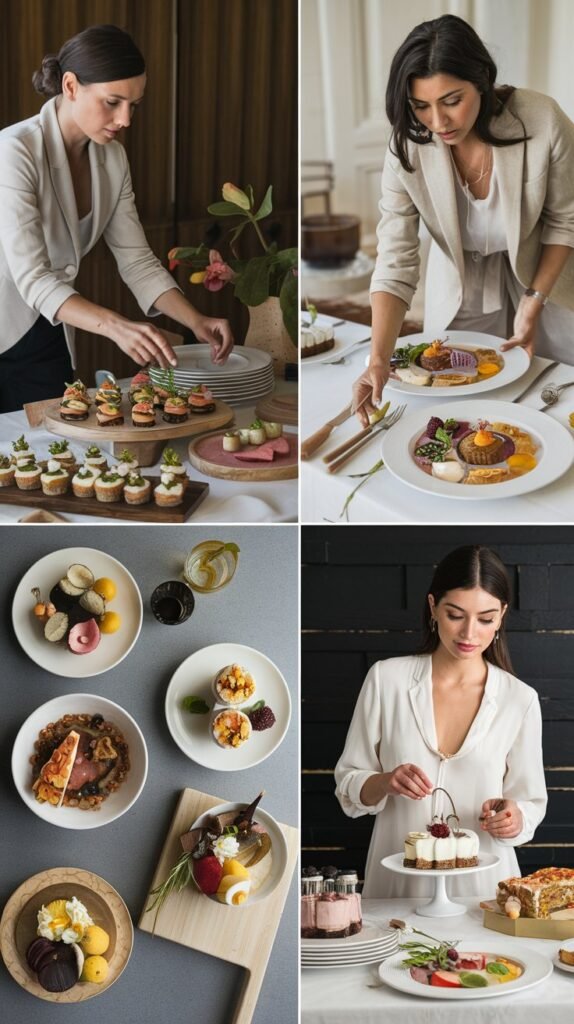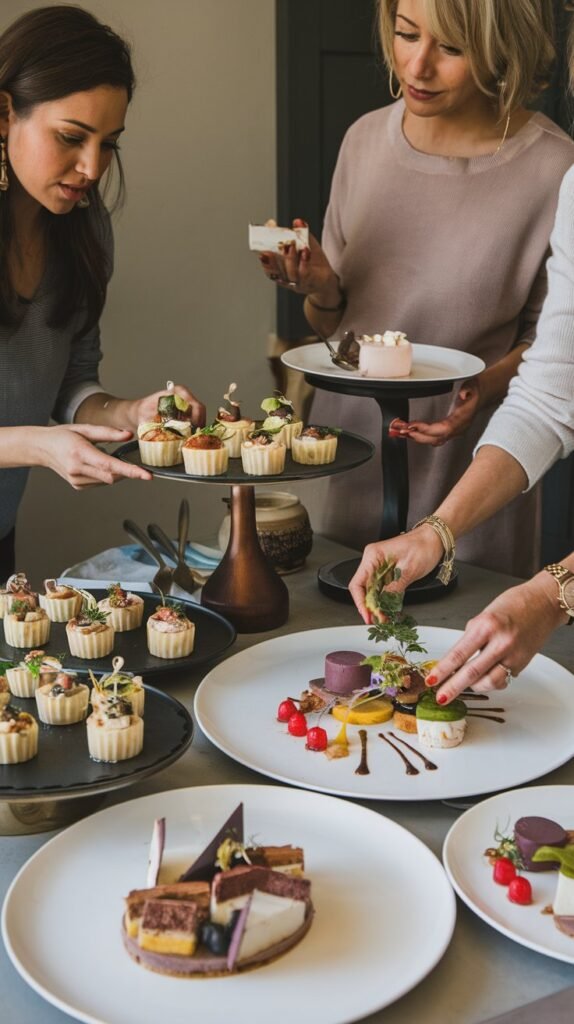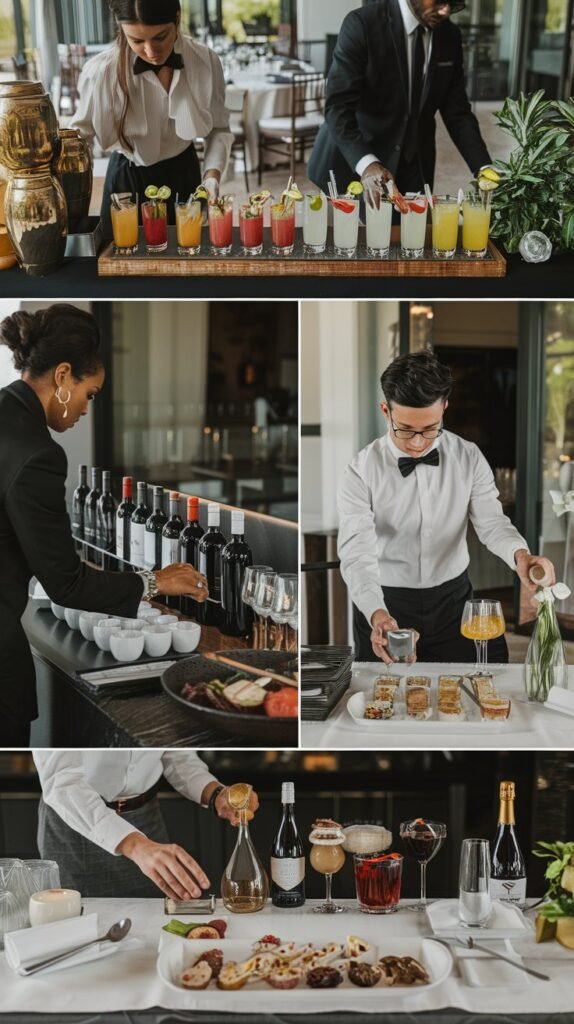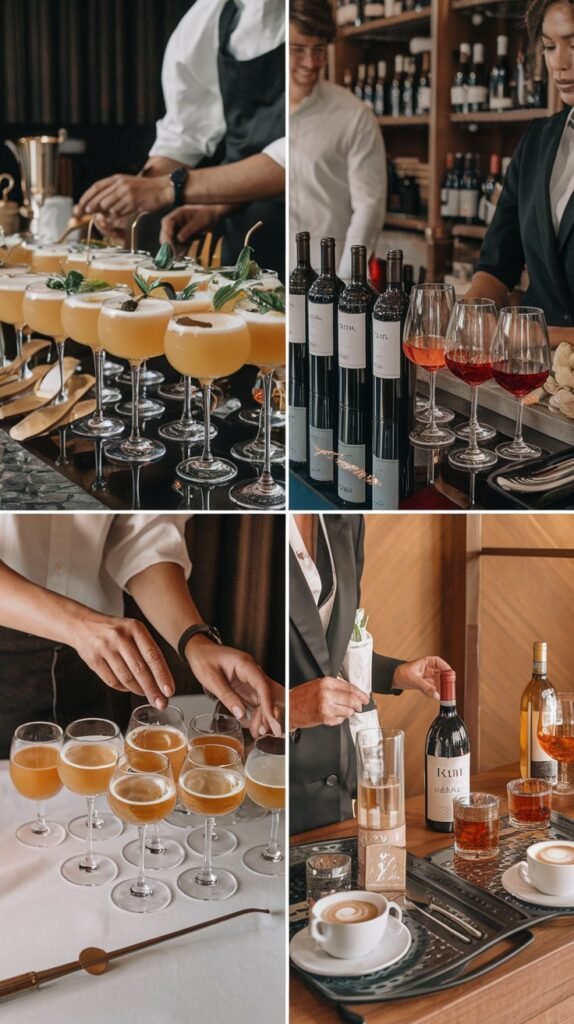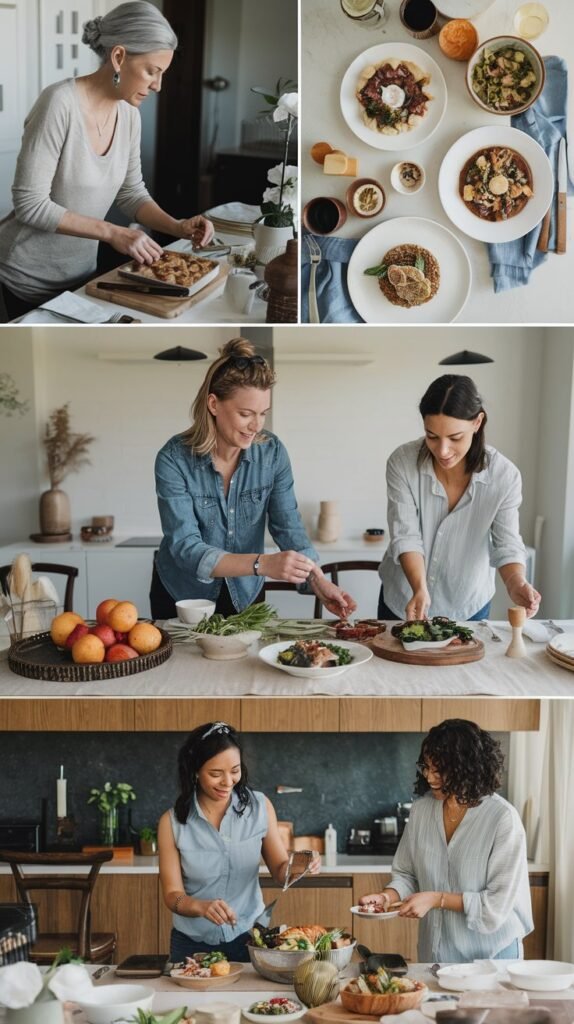There’s something uniquely fulfilling about bringing people together around a thoughtfully prepared meal in the comfort of your own home. Dinner parties transform ordinary evenings into special occasions, creating spaces for meaningful conversation, shared culinary experiences, and the kind of unhurried connection that restaurants rarely allow.
Whether you’re hosting your first dinner party or looking to elevate your established entertaining style, a thoughtful approach to each element—from menu planning to table setting, timing to atmosphere—creates not just a meal but a memorable experience.
Let’s explore how to create the perfect dinner party that balances impressive culinary experiences with genuine hospitality for an unforgettable evening!
Dinner Party Planning Fundamentals
Establish the perfect foundation for your at-home dining celebration.
Understanding Modern Dinner Party Approaches
Creating at-home dining experiences that prioritize connection:
- Hospitality Focus: Prioritizing guest comfort over perfection
- Balanced Hosting Philosophy: Being present with guests, not just serving them
- Menu-Effort Alignment: Creating impressive food without kitchen imprisonment
- Atmosphere Intention: Setting the right mood for your specific gathering
- Guest Comfort Priority: Considering varied preferences and needs
- Connection Facilitation: Creating natural conversation opportunities
- Authenticity Emphasis: Entertaining in your personal style, not a magazine’s
“The most successful dinner parties begin with a fundamental mindset shift from performance to connection,” shares Madison, who specializes in at-home entertaining. “We approach hosting with what we call ‘present hospitality’—creating experiences where the host can be genuinely engaged with guests rather than stuck in kitchen chaos. This means developing menus with significant make-ahead components and establishing realistic preparation timelines.”
Guest List and Invitation Strategy
Creating the right gathering foundation:
- Group Dynamic Consideration: Thoughtful attendee combinations
- Size Determination Process: Appropriate numbers for your space and style
- Clear Communication Priority: Setting accurate expectations
- Dietary Requirement Collection: Addressing needs respectfully
- RSVP Management Planning: Ensuring accurate attendance information
- Timing Clarity: Specific arrival, meal, and ending guidance
- Special Occasion Recognition: Acknowledging celebrations appropriately
“Guest selection creates the essential human foundation for dinner party success,” explains Jordan, who plans diverse gatherings. “We’ve found the most effective approach is what we call ‘intentional combination’—thoughtfully selecting guests who will create interesting conversation chemistry while feeling comfortable together. The ideal size typically ranges from 6-10 people for single-table gatherings, allowing everyone to engage in shared conversation while providing enough social variety.”
Menu Planning Strategy
Developing the culinary foundation:
- Balance and Variety Focus: Complementary flavors and textures
- Season and Availability Consideration: Ingredients at their best
- Advance Preparation Possibility: Make-ahead component identification
- Skill Level Alignment: Dishes matching your culinary comfort
- Special Diet Integration: Accommodating requirements without spotlighting
- Appropriate Quantity Planning: Generous without overwhelming
- Course Flow Development: Natural progression of flavors
“Menu planning requires balancing culinary ambition with practical hosting reality,” shares Olivia, who creates memorable dining experiences. “We develop what we call ‘host-friendly impressive menus’—combinations of dishes that create genuine wow-factor while allowing the host to actually enjoy their own party. We generally recommend centering the menu around a single standout dish surrounded by simpler, make-ahead accompaniments rather than multiple complex preparations.”
Dinner Party Food
Delicious offerings that create a memorable dining experience.
The perfect dinner party menu balances sophistication with practicality, offering guests a thoughtfully sequenced culinary journey while allowing the host to actually enjoy the gathering. From elegant starters to memorable mains and impressive desserts, successful dinner party food considers visual presentation, flavor progression, dietary needs, and preparation timing to create a dining experience that feels special without exhausting the host.
| Elegant Appetizers | Impressive Main Courses | Complementary Side Dishes | Memorable Desserts |
|---|---|---|---|
| Whipped Ricotta Crostini | Beef Wellington | Truffle Mashed Potatoes | Chocolate Soufflé |
| Stuffed Mushrooms | Herb-Crusted Rack of Lamb | Roasted Vegetable Medley | Crème Brûlée |
| Prosciutto-Wrapped Asparagus | Salmon en Papillote | Risotto with Wild Mushrooms | Pavlova with Seasonal Fruit |
| Baked Brie with Preserves | Coq au Vin | Grilled Asparagus with Lemon | Chocolate Lava Cakes |
| Citrus Marinated Olives | Osso Buco | Herb-Roasted Fingerling Potatoes | Panna Cotta with Berries |
| Bacon-Wrapped Dates | Bouillabaisse | Sautéed Green Beans with Almonds | Fresh Fruit Tarts |
| Smoked Salmon Canapés | Vegetable Wellington | Farro with Roasted Vegetables | Tiramisu |
| Goat Cheese & Fig Tartlets | Braised Short Ribs | Wild Rice Pilaf | Flourless Chocolate Cake |
Creating Dinner Party Food Successfully
Techniques for impressive yet manageable dining:
- Make-Ahead Component Identification: Preparation timeline optimization
- Balanced Menu Development: Complementary flavors and textures
- Visual Impact Prioritization: Beautiful presentation techniques
- Dietary Consideration Integration: Seamless accommodation approaches
- Temperature Management Strategy: Hot food staying hot, cold food cold
- Portion Size Calculation: Appropriate serving volumes
- Course Progression Planning: Logical flavor and texture sequence
“I approach dinner party menus with what I call ‘elegant simplicity’—focusing on a few spectacular elements rather than numerous complicated dishes,” shares Marcus, who specializes in home entertaining cuisine. “We recommend centering each meal around one standout course—perhaps a beautifully presented main dish—while surrounding it with simpler, make-ahead sides and starters. This balanced approach creates impressive dining experiences while preventing host exhaustion.”
Dinner Party Beverages
Refreshing sips that complement your menu and enhance the occasion.
Thoughtfully selected beverages elevate a dinner party from simple meal to complete sensory experience, enhancing food flavors while creating celebratory moments throughout the gathering. A well-planned beverage strategy balances alcoholic and non-alcoholic options, considers proper glassware and temperature, and creates natural hosting rhythms from welcome drinks through after-dinner sipping that keep the gathering flowing smoothly from beginning to end.
| Welcome Drinks | Wine Pairings | Non-Alcoholic Options | After-Dinner Beverages |
|---|---|---|---|
| Classic Champagne Cocktail | Crisp Sauvignon Blanc | Sparkling Elderflower Spritz | French Press Coffee Service |
| Negroni Sbagliato | Unoaked Chardonnay | Cucumber Mint Refresher | Espresso with Lemon Twist |
| Aperol Spritz | Light Pinot Noir | Pomegranate Sparkler | Amaretto |
| French 75 | Complex Cabernet | Berry Shrub Mocktail | Dessert Wine Flight |
| Signature House Cocktail | Dry Rosé | Herbal Iced Tea | Port with Cheese |
| Kir Royale | Crisp Riesling | Citrus Infused Water | Baileys and Coffee |
| Seasonal Sangria | Buttery Chardonnay | Virgin Mojito | Chocolate Liqueur |
| Spicy Margarita | Bold Syrah | Blood Orange Fizz | Brandy |
Creating Dinner Party Beverages Successfully
Techniques for impressive yet manageable drink service:
- Welcome Drink Preparation: Pre-gathering beverage mixing
- Wine Selection Simplification: Versatile, food-friendly choices
- Non-Alcoholic Elevation Priority: Thoughtful zero-proof options
- Temperature Management Strategy: Proper chilling techniques
- Self-Service Station Creation: Host freedom enhancement
- Quantity Calculation Method: Appropriate volume planning
- Glassware Preparation Organization: Clean, accessible vessels
“I approach dinner party beverages with what I call ‘hospitable efficiency’—creating impressive drink experiences without constant mixing or serving,” shares Emma, who specializes in home entertaining beverages. “We particularly recommend creating pre-mixed signature welcome cocktails ready in pitchers or bottles for immediate pouring, selecting just two versatile wines that complement your entire menu, and developing a self-service station that allows guests to refresh drinks independently.”
Creating the Perfect Dinner Party Atmosphere
Transform your home into an inviting dining environment.
Table Setting Strategy
Creating beautiful yet functional dining spaces:
- Layered Place Setting Development: Building elegant dining foundations
- Conversation-Friendly Centerpiece Selection: Visibility and interaction priority
- Appropriate Formality Determination: Setting matching occasion significance
- Practical Function Consideration: Comfort and usability beyond aesthetics
- Personal Style Integration: Authentic rather than templated approaches
- Color and Texture Coordination: Visual harmony without rigidity
- Space Optimization: Comfortable settings within your available area
“I approach table design with what I call ‘inviting sophistication’—creating settings that feel special without becoming intimidating or impractical,” explains Elena, who designs dining experiences. “We begin with layered place settings that signal celebration—perhaps cloth napkins, multiple glassware options, and complete flatware—while ensuring practical function for the specific menu. We select centerpieces that enhance atmosphere without blocking sightlines—low floral arrangements, scattered candleholders, or natural elements.”
Lighting and Ambiance Development
Setting the perfect mood:
- Multiple Light Source Integration: Layered illumination strategy
- Flattering Light Priority: Warm, complimentary glow creation
- Practical Function Balance: Seeing food while maintaining atmosphere
- Candle Strategy Development: Safe, effective flame incorporation
- Natural Light Transition Planning: Daytime to evening progression
- Flexibility Consideration: Adjustable options throughout evening
- Special Feature Highlighting: Focusing attention on key elements
“Lighting creates the emotional foundation for successful dinner parties, particularly in transitioning spaces from everyday function to evening elegance,” shares Sofia, who designs atmospheric environments. “We develop what we call ‘layered illumination’—combining multiple light sources at different heights and intensities to create depth and warmth. We typically reduce overhead lighting which can feel harsh, instead emphasizing table lamps, wall sconces, candles, and string lights.”
Music and Background Elements
Creating subtle sensory enhancement:
- Volume Level Strategy: Supporting rather than dominating
- Playlist Duration Planning: Coverage for entire gathering
- Style-Atmosphere Alignment: Music matching desired mood
- Transition Consideration: Energy progression throughout evening
- Conversation Support Priority: Enhancing rather than hindering interaction
- Background Scent Integration: Subtle aromatic elements
- Temperature and Comfort Assessment: Physical ease for extended dining
“Background elements should enhance the dining experience without demanding attention themselves,” explains Rafael, who creates sensory environments. “We focus on what we call ‘atmospheric support’—elements that contribute to mood while remaining firmly secondary to food and conversation. Music selection requires particular thoughtfulness—playlists that provide consistent, appropriate energy without jarring transitions or lyrics that dominate attention.”
Dinner Party Culinary Execution
Creating impressive dining experiences with minimized host stress.
Strategic Food Preparation Approaches
Creating impressive meals without kitchen imprisonment:
- Make-Ahead Component Maximization: Advance preparation opportunities
- Final Touch Identification: Last-minute elements for freshness
- Passive Cooking Utilization: Oven or slow-cooker methods during gathering
- Complexity Distribution Planning: Balancing intense and simple preparations
- Room Temperature Option Integration: Quality dishes without timing stress
- Presentation Enhancement Focus: Simple elements with visual impact
- Fail-Safe Backup Integration: Emergency alternatives for peace of mind
“I approach dinner party cooking with what I call ‘strategic culinary planning’—creating impressive meals through thoughtful preparation sequencing rather than day-of complexity,” shares Priya, who specializes in entertaining cuisine. “We identify which components improve with advance preparation—like braised dishes, composed salads, or desserts—completing these entirely ahead. We determine which elements benefit from partial preparation—perhaps vegetables prepped but roasted last-minute or proteins marinated ahead but cooked during the party.”
Serving Style Decisions
Finding your ideal food presentation approach:
- Plated vs. Family-Style Assessment: Service style matching your gathering
- Course Progression Planning: Meal flow and timing strategy
- Temperature Maintenance Consideration: Keeping hot food hot, cold food cold
- Practical Serving Piece Selection: Function alongside beauty
- Guest Self-Sufficiency Balance: Independence without abandonment
- Special Dietary Identification: Discreet accommodation methods
- Kitchen-to-Table Efficiency: Minimizing transition times
“Serving style significantly impacts both the dining experience and the host’s ability to remain present rather than constantly in motion,” explains Taylor, who coordinates dining experiences. “We help hosts find their ideal approach through what we call ‘hospitality-forward service’—selecting methods that enhance rather than detract from connection. Traditional coursed, plated service creates elegant experiences but requires significant host attention. Family-style service with platters passed among guests creates immediate community but requires careful dish selection.”
Beverage Strategy Development
Creating perfect drink pairings and service:
- Wine Pairing Simplification: Approachable selection processes
- Non-Alcoholic Option Elevation: Sophisticated alcohol-free choices
- Pre-Dinner Drink Consideration: Welcome beverage planning
- Self-Service Station Possibility: Guest independence creation
- Glassware Selection Strategy: Appropriate vessels for beverages
- Temperature Management Plan: Proper serving conditions
- After-Dinner Option Integration: Meal conclusion beverages
“Beverage service creates another dimension of hospitality when thoughtfully planned to enhance rather than complicate the gathering,” shares Maya, who develops comprehensive dining experiences. “We create what we call ‘accessible sophistication’—impressive but uncomplicated beverage approaches that complement the meal without requiring sommelier-level knowledge. For wine, we typically recommend selecting just two options—a versatile white and red that complement your menu rather than numerous specific pairings.”
Dinner Party Hosting Execution
Being a present, relaxed host while managing the gathering.
Creating Thoughtful Guest Arrivals
Starting the gathering with warm hospitality:
- Welcome Moment Design: First impression hospitality
- Initial Beverage Offering: Immediate refreshment provision
- Coat and Belonging Management: Practical comfort creation
- Home Navigation Guidance: Bathroom and space orientation
- Early Conversation Facilitation: Initial interaction support
- Arrival Timing Buffer Planning: Accommodation for variability
- Special Need Addressing: Immediate comfort establishment
“First impressions establish the entire emotional foundation for dinner gatherings,” shares Jordan. “We focus on what we call ‘immediate hospitality signaling’—creating arrival experiences that instantly communicate thoughtful care. This includes greeting guests personally at the door rather than shouting from the kitchen, offering welcome beverages within moments of arrival, having designated space for coats and bags, and providing subtle orientation to your home including bathroom location.”
Conversation Facilitation Strategies
Creating natural, inclusive interaction:
- Initial Topic Preparation: Thoughtful conversation starters
- Guest Connection Identification: Finding shared interests
- Inclusion Awareness: Engaging quieter participants
- Depth Progression Planning: Moving beyond small talk naturally
- Controversial Topic Navigation: Managing potential tensions
- Host Participation Balance: Leading without dominating
- Natural Transition Creation: Shifting conversation gracefully
“Meaningful conversation remains the heart of successful dinner parties, yet requires subtle facilitation rather than forced direction,” explains Olivia. “We develop what we call ‘organic connection pathways’—creating natural opportunities for significant interaction without obvious manipulation. This includes thoughtful seating arrangements that position complementary personalities near each other, having several interesting questions or topics prepared to overcome initial hesitation, and being attentive to conversation flow.”
Graceful Gathering Conclusion
Creating natural, positive endings:
- Timing Signal Integration: Subtle conclusion indication
- Dessert and Final Course Strategy: Transitional food moments
- After-Dinner Beverage Offering: Conclusion drink considerations
- Departure Facilitation Approach: Supporting natural endings
- Leftover Management Planning: Food sharing opportunities
- Thank You Moment Creation: Appreciation expression
- Follow-Up Consideration: Post-gathering connection extension
“Ending gatherings naturally creates the final impression guests carry forward,” shares Sofia. “We create what we call ‘graceful conclusion pathways’—helping evenings end organically without awkwardness. The dessert course often serves as a natural transition signal, especially when moved to a different space like a living room, creating both continuation and subtle shift toward conclusion. Coffee or digestif offerings provide another natural phase before departure.”
Special Dinner Party Variations
Adapt your approach for different occasions and needs.
Intimate Small-Group Dinners
Creating special experiences for fewer guests:
- Enhanced Individual Attention: Personalized hosting approaches
- Menu Elaboration Possibility: More complex culinary options
- Deeper Conversation Facilitation: Meaningful interaction development
- Specialized Beverage Pairing: More specific drink selections
- Detailed Presentation Opportunity: Elevated visual elements
- Extended Experience Planning: Longer gathering potential
- Heightened Customization: Tailoring to specific guest preferences
“Intimate dinners for 4-6 guests create opportunities for deeper connection and more elaborate culinary experiences,” explains Rafael, who specializes in small-group gatherings. “We focus on what we call ‘elevated intentionality’—using the advantages of smaller numbers to create more personalized experiences. With fewer guests, hosts can prepare more intricate dishes, offer coursed experiences without kitchen chaos, and create more elaborate table settings with special details for each guest.”
Larger Dinner Gatherings
Managing expanded guest numbers successfully:
- Multiple Table Consideration: Beyond single-table limitations
- Simplified Service Necessity: Streamlined food approaches
- Traffic Flow Planning: Movement through spaces
- Group Conversation Strategy: Beyond single-table interaction
- Self-Service Integration: Guest independence elements
- Kitchen Management Expansion: Handling increased production
- Seating Strategy Development: Various arrangement possibilities
“Larger dinner parties require strategic shifts in approach rather than simply scaling up intimate dinner plans,” shares Aisha, who organizes expanded gatherings. “We develop what we call ‘managed abundance’—creating impressive yet practical experiences for groups beyond single-table size. For food, we emphasize fewer, simpler dishes prepared in larger quantities rather than numerous complex options. We establish practical serving approaches—perhaps elegant buffets, food stations, or pre-plated first courses with family-style mains.”
Themed Dining Experiences
Creating immersive celebration concepts:
- Cohesive Theme Development: Unifying concept selection
- Menu-Theme Alignment: Food that enhances concept
- Decor Integration Strategy: Environmental theme support
- Activity Consideration: Interactive themed elements
- Invitation Thematic Introduction: Setting expectations appropriately
- Practical Limitation Recognition: Manageable theme execution
- Guest Participation Opportunity: Involvement in themed elements
“Themed dinner parties create memorable experiences through cohesive concepts that transform ordinary gatherings into immersive celebrations,” explains Jordan. “We approach themes with what we call ‘sophisticated immersion’—developing concepts that feel elevated rather than gimmicky. Successful themes typically center around cultural cuisine explorations, historical era interpretations, literary inspirations, or seasonal celebrations rather than costume-party concepts. We thoughtfully integrate thematic elements across multiple touchpoints—invitations that introduce the concept, decor that subtly enhances without overwhelming, menu items that directly connect.”
Dietary-Focused Gatherings
Accommodating various food needs gracefully:
- Inclusive Menu Development: Naturally accommodating approaches
- Restriction-Delicious Priority: Beyond mere accommodation
- Discreet Variation Creation: Addressing needs without spotlighting
- Cross-Contamination Prevention: Safety with multiple requirements
- Shared Experience Maintenance: Collective dining despite differences
- Communication Strategy: Understanding needs without awkwardness
- Positive Framing Focus: Celebration rather than limitation emphasis
“Dietary-diverse gatherings require thoughtful planning that addresses requirements while maintaining the joyful, communal nature of shared meals,” shares Maya. “We focus on what we call ‘inclusive abundance’—creating experiences where food restrictions never become the center of attention or a source of separation. We develop naturally accommodating menus where most elements work for everyone, perhaps with minor modifications rather than entirely different ‘special meals.'”
More Creative Dinner Party Inspiration
Looking for additional at-home dining celebration ideas? Here’s a collection of creative concepts!
| Creative Dinner Party Concepts | Unique At-Home Dining Ideas | Themed Gathering Experiences |
|---|---|---|
| Progressive Course Journey | Blind Tasting Experience | Historical Era Dinner |
| Chef’s Table Demonstration | Conversation Menu Cards | International Street Food |
| Cookbook Club Gathering | Harvest Table Celebration | Literary Favorite Meals |
| Wine Region Exploration | Seasonal Ingredient Spotlight | Film-Inspired Dining |
| Heirloom Recipe Sharing | Breakfast-for-Dinner Elegance | Color Palette Meal |
| Collaborative Cooking Party | Vertical Ingredient Tasting | Family Heritage Celebration |
| Market-to-Table Experience | Silent Dinner Mindfulness | Music-Inspired Courses |
Conclusion: Celebrating Connection Through Thoughtful At-Home Dining
Dinner parties create meaningful memories through the perfect combination of delicious food, warm atmosphere, and genuine hospitality.
What makes dinner parties extraordinary is their ability to transform ordinary evenings into meaningful connections through the universal language of shared food and conversation. When thoughtfully planned with attention to both impressive culinary elements and genuine hospitality, these at-home gatherings create the increasingly rare opportunity for unhurried, phone-free interaction centered around one of life’s most fundamental pleasures.
So plan your menu, set your table, create your timeline, and invite people to gather around your table. The memories you create through these in-home dining experiences will become treasured moments of connection in a world that increasingly lacks opportunities for genuine, focused togetherness!







